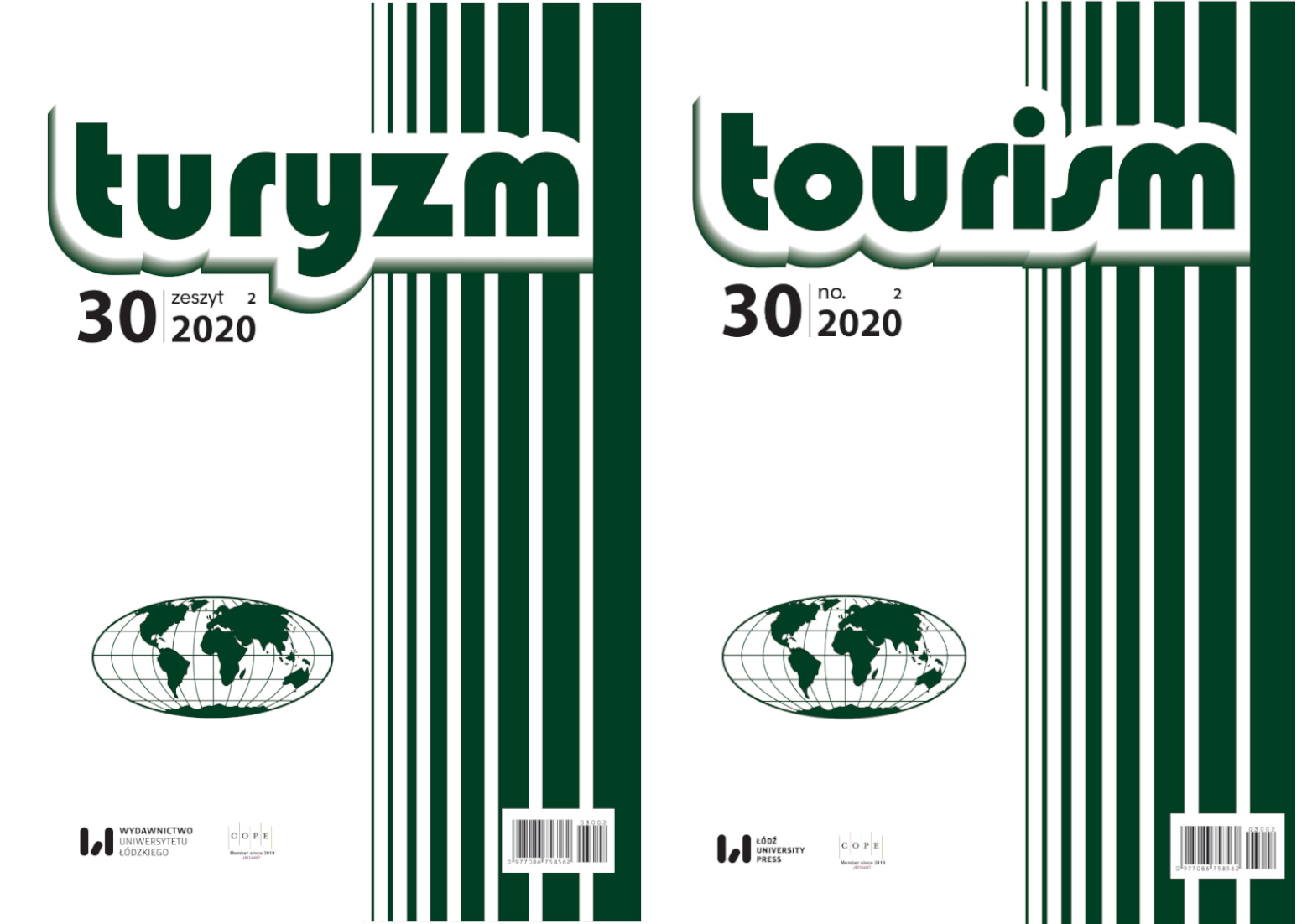Fan tourism and fan tourists: discussion on definitions and research issues
DOI:
https://doi.org/10.18778/0867-5856.30.2.18Keywords:
fan tourism, fan tourist, sports tourism, cultural tourism, fan, fanatic, sports fanAbstract
The purpose of the article is to systematize the concepts of fan tourism and fan tourists and an attempt has also been made to identify the profile of a fan tourist. There are certain research gaps in terms of defining the concept itself, therefore the authors have decided to investigate this. Literature analysis and criticism as well as synthesizing ideas were methods used in this work. The article presents the characteristics of fan tourism and a description of a fan tourist using psychological, social and economic criteria identified on the basis of a literature investigation. The following attributes were distinguished: the main motive of activity, emotional involvement, ‘extreme’ support, commitment to ideas, sympathy towards ideas, personal attendance at an event and the nature of a consumer or a prosumer when a fan tourist participates in an event personally. The concepts of a fan in general, fanatic and sports fan (kibic) were used in the process of identifying the characteristics of a fan tourist.
Downloads
References
Alejziak, W. (2016). Sports tourism: A contribution to a debate on its definition and research subject matter. Turyzm/Tourism, 26 (1), 85-88. DOI: https://doi.org/10.18778/0867-5856.26.1.10
Google Scholar
DOI: https://doi.org/10.18778/0867-5856.26.1.10
Beeton, S. (2005). Film-induced tourism. Clevedon: Channel View Publications. DOI: https://doi.org/10.21832/9781845410162
Google Scholar
DOI: https://doi.org/10.21832/9781845410162
Billig, M. (2008). Banalny nacjonalizm. Cracow: Wydawnictwo Znak.
Google Scholar
Brumm, K. (2012). Fanoturystyka. Kibice sportowi w pozytywnym świetle. Poznań: K&AK.M.A. Karasiak.
Google Scholar
Buczkowska, K. (2008). Turystyka kulturowa. Przewodnik metodyczny. Poznań: Akademia Wychowania Fizycznego im. Eugeniusza Piaseckiego w Poznaniu.
Google Scholar
Cho, H., Joo, D., Chi, C. (2019). Examining nostalgia in sport tourism: The case of US college football fans. Tourism Management Perspectives, 29, 97-104. DOI: https://doi.org/10.1016/j.tmp.2018.11.002
Google Scholar
DOI: https://doi.org/10.1016/j.tmp.2018.11.002
Couldry, N. (2007). On the set of the sopranos: ‘Inside’ a fan’s construction of nearness. In: J. Gray, C. Sandvoss, C. L. Harrington (eds), Fandom: Identities and communities in a mediated world (pp. 139-148). New York: Nowy Jork University Press.
Google Scholar
Długosz-Kurczabowa, K. (2008). Wielki słownik etymologiczno-historyczny języka polskiego. Warsaw: Wydawnictwo Naukowe PWN.
Google Scholar
Dotson, M.J., Clark, J.D., Suber, M.B., Dave, D.S. (2013). Millennials’ perceptions of spectator sports. Services Marketing Quarterly, 34 (3), 215-230. DOI: https://doi.org/10.1080/15332969.2013.798196
Google Scholar
DOI: https://doi.org/10.1080/15332969.2013.798196
Dudała, J. (2004). Fani-chuligani. Rzecz o polskich kibolach. Studium socjologiczne. Warsaw: Wydawnictwo Akademickie Żak.
Google Scholar
Fan (2020a). Retrieved from: https://dictionary.cambridge.org/pl/dictionary/english/fan (1.02.2020).
Google Scholar
Fan (2020b). Retrieved from: https://sjp.pwn.pl/szukaj/fan.html (1.02.2020).
Google Scholar
Fanatyk (2020). Retrieved from: https://sjp.pwn.pl/sjp/fanatyk;2557478.html (1.02.2020).
Google Scholar
Florek, M., Breitbarth, T., Conejo, F. (2008). Mega event = mega impact? Travelling fans’ experience and perceptions of the 2006 FIFA World Cup host nation. Journal of Sport & Tourism, 13 (3), 1-20. DOI: https://doi.org/10.1080/14775080802310231
Google Scholar
DOI: https://doi.org/10.1080/14775080802310231
Forest, F. (1991). 50 podstawowych pojęć kultury współczesnej. Wyjaśnienia i komentarze. Retrieved from: http://docplayer.pl/68734087-50-podstawowych-pojec-kultury-wspolczesnej.html (1.02.2020).
Google Scholar
Geraghty, L. (2014). It’s not all about the music: Online fan communities and collecting Hard Rock Café pins. Transformative Works and Cultures, 16. DOI: https://doi.org/10.3983/twc.2014.0492
Google Scholar
DOI: https://doi.org/10.3983/twc.2014.0492
Geraghty, L. (2018). Passing through: Popular media tourism, pilgrimage and narratives of being a fan. In: C. Lundberg, V. Ziakas (eds), The Routledge handbook of popular culture and tourism. New York: Taylor & Francis Group. DOI: https://doi.org/10.4324/9781315559018-19
Google Scholar
DOI: https://doi.org/10.4324/9781315559018-19
Geraghty, L. (2019). Everybody needs good neighbours. In: C. Lam, J. Raphael (eds), Aussie fans: Uniquely placed in global popular culture (pp. 89-104). Iowa City: University of Iowa Press. DOI: https://doi.org/10.2307/j.ctvq4c15d.9
Google Scholar
DOI: https://doi.org/10.2307/j.ctvq4c15d.9
Hanks, L., Zhang, L., McGinley, S. (2016). Unconditioned superstition and sports bar fans. Journal of Hospitality Marketing and Management, 25 (1), 113-131. DOI: https://doi.org/10.1080/19368623.2014.987417
Google Scholar
DOI: https://doi.org/10.1080/19368623.2014.987417
Hinch, T., Higham, J. (2001). Sport tourism: A framework of research. International Journal of Tourism Reserarch, 3 (1), 45-58. DOI: https://doi.org/10.1002/1522-1970(200101/02)3:1<45::AID-JTR243>3.0.CO;2-A
Google Scholar
DOI: https://doi.org/10.1002/1522-1970(200101/02)3:1<45::AID-JTR243>3.0.CO;2-A
Iwashita, C. (2006). Media representation of the UK as a destination for Japanese tourists: Popular culture and tourism. Tourist Studies, 6 (1), 59-77. DOI: https://doi.org/10.1177/1468797606071477
Google Scholar
DOI: https://doi.org/10.1177/1468797606071477
Jaszewska, D. (2011). Kultura – rzecz gustu? O kilku granicach supermarketyzacji kultury. Kultura – Media – Teologia, 4, 19-33.
Google Scholar
Karpovich, A.I. (2010). Theoretical approaches to film-motivated tourism. Tourism and Hospitality Planning & Development, 7 (1), 7-20. DOI: https://doi.org/10.1080/14790530903522580
Google Scholar
DOI: https://doi.org/10.1080/14790530903522580
Kondraciuk, P. (2019). Preferencje turystyczne kibiców żużlowych w Polsce. Annales Universitatis Paedagogicae Cracoviensis Studia Geographica, 13, 130-142.
Google Scholar
DOI: https://doi.org/10.24917/20845456.13.9
Kurek, W. (ed.) (2007). Turystyka. Warsaw: Wydawnictwo Naukowe PWN.
Google Scholar
Lisowska-Magdziarz, M. (2017). Fandom dla początkujących. Cracow: Instytut Dziennikarstwa, Mediów i Komunikacji Społecznej, Uniwersytet Jagielloński.
Google Scholar
Liszewski, S. (2016). Remarks on sports tourism as a reflection on „Relations between tourism and sport concerning the organization of tourism studies” by J. Kotus. Turyzm/Tourism, 26 (1), 27-29. DOI: https://doi.org/10.18778/0867-5856.26.1.04
Google Scholar
DOI: https://doi.org/10.1515/tour-2016-0002
Mokras-Grabowska J. (2016). Sports tourism: terminological discussion. Turyzm/Tourism, 26 (1), 13-18. DOI: https://doi.org/10.18778/0867-5856.26.1.02
Google Scholar
DOI: https://doi.org/10.1515/tour-2016-0001
Morrison, K.A., Misener, K.E., Mock, S.E. (2020). The influence of corporate responsibility and team identification on spectator behavior in major junior hockey. Leisure Sciences, 42 (2), 133-151. DOI: https://doi.org/10.1080/01490400.2017.1408511
Google Scholar
DOI: https://doi.org/10.1080/01490400.2017.1408511
Norris, C. (2016). Japanese media tourism as world-building: Akihabara’s Electric Town and Ikebukuro’s Maiden Road. Participations: Journal of Audience & Reception Studies, 13 (1), 656-681.
Google Scholar
Pikora, M. (2013). Aktorzy, kreatorzy, konsumenci widowiska sportowego. Rzecz o polskich klubowych kibicach piłkarskich. Studia Socjologiczne, 3 (210), 151-173.
Google Scholar
Poniatowski, Z. (1969). Mały słownik religioznawczy. Warsaw: Wiedza Powszechna.
Google Scholar
PricewaterhouseCoopers (2020). PwC sports outlook – at the gate and beyond. Outlook for the sports market in North America through 2021. Retrieved from: https://www.pwc.com/us/en/industries/entertainment-media/publications/sports-Outlook-north-america.html (4.08.2020).
Google Scholar
Ramirez-Hurtado, J.M., Berbel-Pineda, J.M. (2015). Identification of segments for overseas tourists playing golf in Spain: A latent class approach. Journal of Hospitality Marketing and Management, 24 (6), 652-680. DOI: https://doi.org/10.1080/19368623.2014.934980
Google Scholar
DOI: https://doi.org/10.1080/19368623.2014.934980
Roche, S., Spake, D.F., Joseph, M. (2013). A model of sporting event tourism as economic development. Sport, Business and Management: An International Journal, 3, (2), 147-157. DOI: https://doi.org/10.1108/20426781311325078
Google Scholar
DOI: https://doi.org/10.1108/20426781311325078
Ryśnik, J. (2019). Identification and evaluation of factors influencing sports fan attendance at international events: volleyball case study. Turyzm/Tourism, 29 (2), 123-135. DOI: https://doi.org/10.18778/0867-5856.29.2.12
Google Scholar
DOI: https://doi.org/10.18778/0867-5856.29.2.12
Siuda, P. (2010). Jednostkowe aspekty bycia fanem, czyli w stronę nowego paradygmatu fan studies. Kultura i Edukacja, 4 (78), 74-94.
Google Scholar
Stasiak, A., Włodarczyk, B. (2015). Czy turystyka może nie być aktywna? O potrzebie podziałów i klasyfikacji turystyki. In: A. Stasiak, J. Śledzińska, B. Włodarczyk (eds), Wczoraj, dziś i jutro turystyki aktywnej i specjalistycznej (pp. 39-52). Warsaw: Wydawnictwo PTTK „Kraj”.
Google Scholar
Theodorakis, N.D., Kaplanidou, K., Karabaxoglou, I. (2015). Effect of event service quality and satisfaction on happiness among runners of a recurring sport event. Leisure Sciences, 37 (1), 87-107. DOI: https://doi.org/10.1080/01490400.2014.938846
Google Scholar
DOI: https://doi.org/10.1080/01490400.2014.938846
Twitter Internal & Crimson Hexagon (2020). Tweet data geo-filtered for US market, growth stats compare Q4/2019 vs. Q1/2016. Retrieved from: https://marketing.twitter.com/content/dam/marketing-twitter/culture-tracker/twittertrend-my-identity-fandom.pdf (2.08.2020).
Google Scholar
Walters, G., Shipway, R., Miles, L., Aldrigui, M. (2017). Fandom and risk perceptions of Olympic tourists. Annals of Tourism Research, 66, 210-212. DOI: https://doi.org/10.1016/j.annals.2017.07.012
Google Scholar
DOI: https://doi.org/10.1016/j.annals.2017.07.012
Williams, R. (2017). Fan tourism and pilgrimage. In: M.A. Click, S. Scott (eds), The Routledge companion to media fandom (pp. 98-106). Londyn: Routledge. DOI: https://doi.org/10.4324/9781315637518-13
Google Scholar
DOI: https://doi.org/10.4324/9781315637518-13
Williams, R. (2019). Funko Hannibal in Florence: Fan tourism, transmediality, and paratextual-spatio-play. JOMEC Journal, 14, 71-90. DOI: https://doi.org/10.18573/jomec.179
Google Scholar
DOI: https://doi.org/10.18573/jomec.179
Włodarczyk, B. (2016). Łódź as an arena of grand sport events: selected examples. Turyzm/Tourism, 26 (1), 49-59. DOI: https://doi.org/10.18778/0867-5856.26.1.06
Google Scholar
DOI: https://doi.org/10.1515/tour-2016-0004
Downloads
Published
How to Cite
Issue
Section
License

This work is licensed under a Creative Commons Attribution-NonCommercial-NoDerivatives 4.0 International License.










